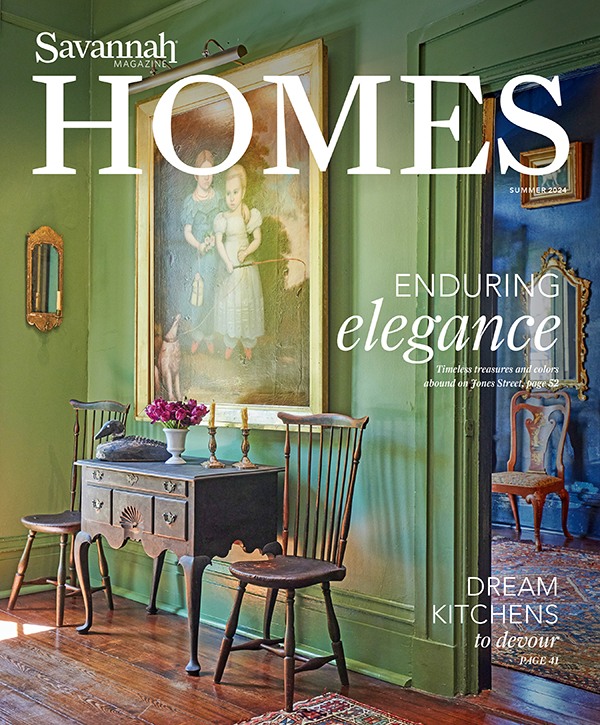Ships of the Sea Maritime Museum celebrates two bicentennials with a splash
There is a garden behind a gate at 41 Martin Luther King Jr. Boulevard — you know the one. It’s the perfect spot to escape the bustle of downtown, find a bench in the shade — perhaps adjacent to the cast-iron weather kiosk that stood in Wright Square from 1870 to World War II — and enjoy a few quiet minutes in the lush greenery of the largest private gardens within the historic district of Savannah.
Just beyond the gardens is the Scarbrough House proper, built in 1819, now home to the Ships of the Sea Maritime Museum. The museum boasts nine galleries of to-scale ship models — among them the SS Savannah, which made history as the first steamship to cross the Atlantic Ocean, a 10,000 mile, six-month journey.
The museum is often the site of art exhibits by local artists, too. Executive director Catherine Adler highlights the importance of making community connections by supporting local artists. “We love inviting the community to enjoy the property for openings and celebrations,” she notes. For instance, on National Maritime Day on May 22 (the same day in 1819 the SS Savannah set sail to Europe), Robert Morris, artist and senior director of corporate communications for the Georgia Ports Authority, unveiled his two eight-foot paintings exploring the SS Savannah in both historical and contemporary contexts. The paintings will be on display until January 2020 as part of the museum’s bicentennial celebrations.

The Scarbrough House was built in 1819 for William Scarbrough, a North Carolina-born shipping merchant and president of the Savannah Steamship Company. Scarbrough also happened to be the principal investor in the SS Savannah — which was a financial failure, sinking off of Fire Island in 1821 after its transatlantic triumph and subsequent conversion to a sailboat. The public just wasn’t ready to trust a steam-operated vessel to get them across the ocean — in fact, the next U.S.-owned steamship didn’t cross the Atlantic until 1847. Driven into debt by a boat ahead of its time, Scarbrough lost the house on what was then West Broad Street not long after it was built.
The house was designed and built by William Jay, an architect from London who, during his four-year tenure in Savannah, designed the Owens-Thomas House, the Telfair House and the Bulloch House, among others. The Scarbrough House is one of the earliest examples of Greek Revival architecture in the South and has been meticulously restored to its 19th century glory (both by the Historic Savannah Foundation in the early 1970s and by Ships of the Sea when the museum acquired the property in 1995), down to the floor coverings and palmette decorative flourishes above the windows. Today, the house’s facade features columns and repeated semi-circular motifs, while inside visitors will find curved walls, a massive double height foyer with skylight and fireplace mantels and walls painted to look like marble. According to Adler, the faux marbling would have been prestigious at the time because it meant a person could afford to hire an artisan for painstaking hours of craftsmanship.
The history of the house doesn’t end with its architecture, though. It’s long been known that Scarbrough House was the site of the West Broad Street School for African-American children from 1878 to 1962. After many owners, including the Catholic Church, the house was bought by George W.J. De Renne, who deeded it to the City of Savannah Board of Public Education to be used exclusively as the first public school for African-American children in Savannah. After De Renne died, according to his will, his heirs were to keep tabs on the school and its upkeep. Funding from the city was always a struggle, but West Broad Street School was helmed by a number of stalwart leaders, including its first principal, James Porter. It and eventually became well-known for its theater program and graduated hundreds of African-American students in Savannah until it closed in 1962.

Now, in honor of the home’s 200th year, a lesser-known history of the house will be the subject of a new exhibit called The Shadows of Scarbrough House: Materializing the Women Who Lived and Ruled Here. The exhibit will open in the fall and illuminate the history of the house through the lens of the women who owned and ran it early on. In the course of 13 years, Wendy Melton, curator of exhibits and education at Ships of the Sea, discovered that the house actually belonged to Scarbrough’s wife, Julia. He’d given the property to her and their future children on their wedding day, but while the gift was recorded in North Carolina where they married, it was never transferred to Chatham County. The house was also legally owned by the Scarbroughs’ daughter Charlotte at one point, in a saga featuring a Supreme Court case to win it backs.
According to Melton, the exhibit brings to light a history of the house that has been forgotten, or misinterpreted: Scarbrough’s wife Julia and his daughter Charlotte were “both independent and strong-willed — two qualities not necessarily appreciated in the ‘fairer sex’ of the 19th century,” she says.
Other bicentennial efforts at Ships of the Sea will include the restoration of that cast-iron weather kiosk in the gardens and the installation of a modern weather station on the other side of the gardens that will broadcast on Weather Underground. “There’s always been an intimate connection between these weather kiosks and communication with the public, whether via telegraph or internet,” says Adler, “and we want to highlight that in our gardens.”
The gardens will soon feature a plant labeling system for its collection of camellias, azaleas, magnolias and more, including a bar code that connects to a plant identification app. And a new Tour Buddy app — developed here in Savannah — will “add historical context to the museum experience,” says Adler, featuring stories and anecdotes about the larger Savannah community — and the world — as they relate to the museum’s three-fold mission of stewarding its maritime collection, the home and the gardens into the next century.


